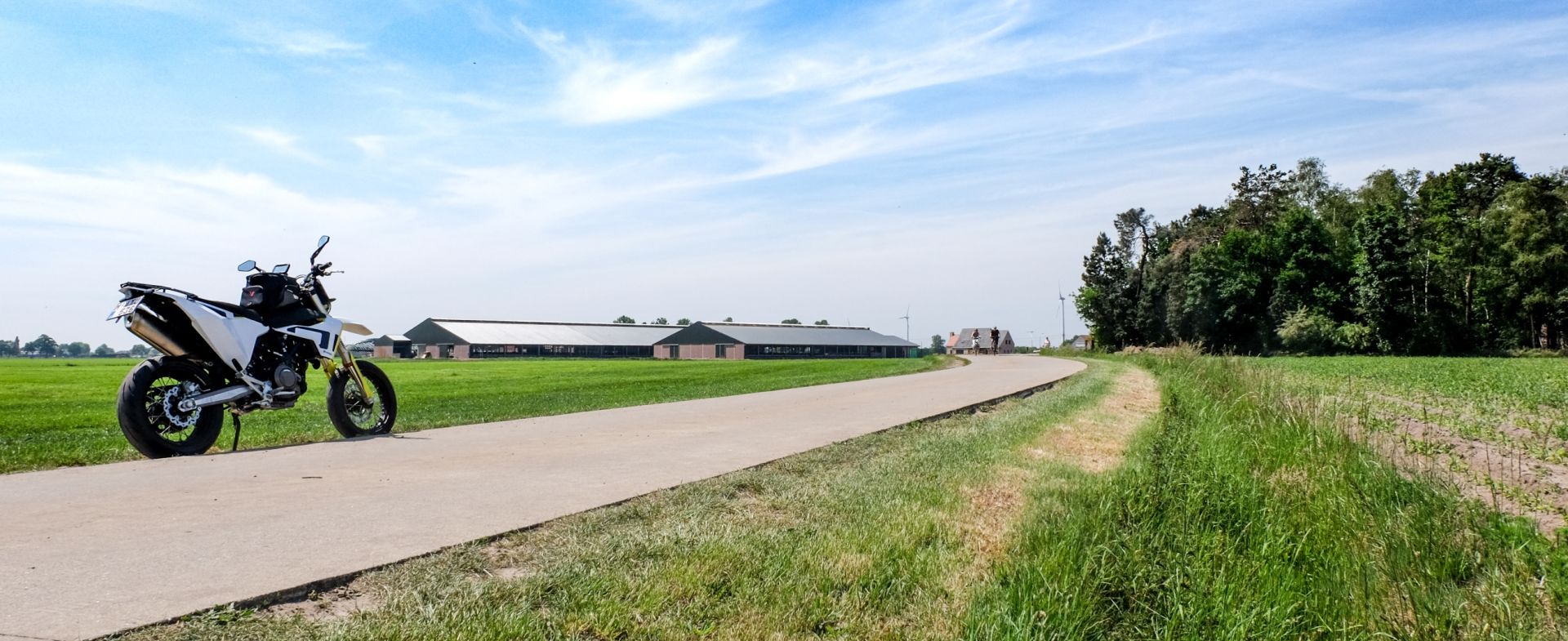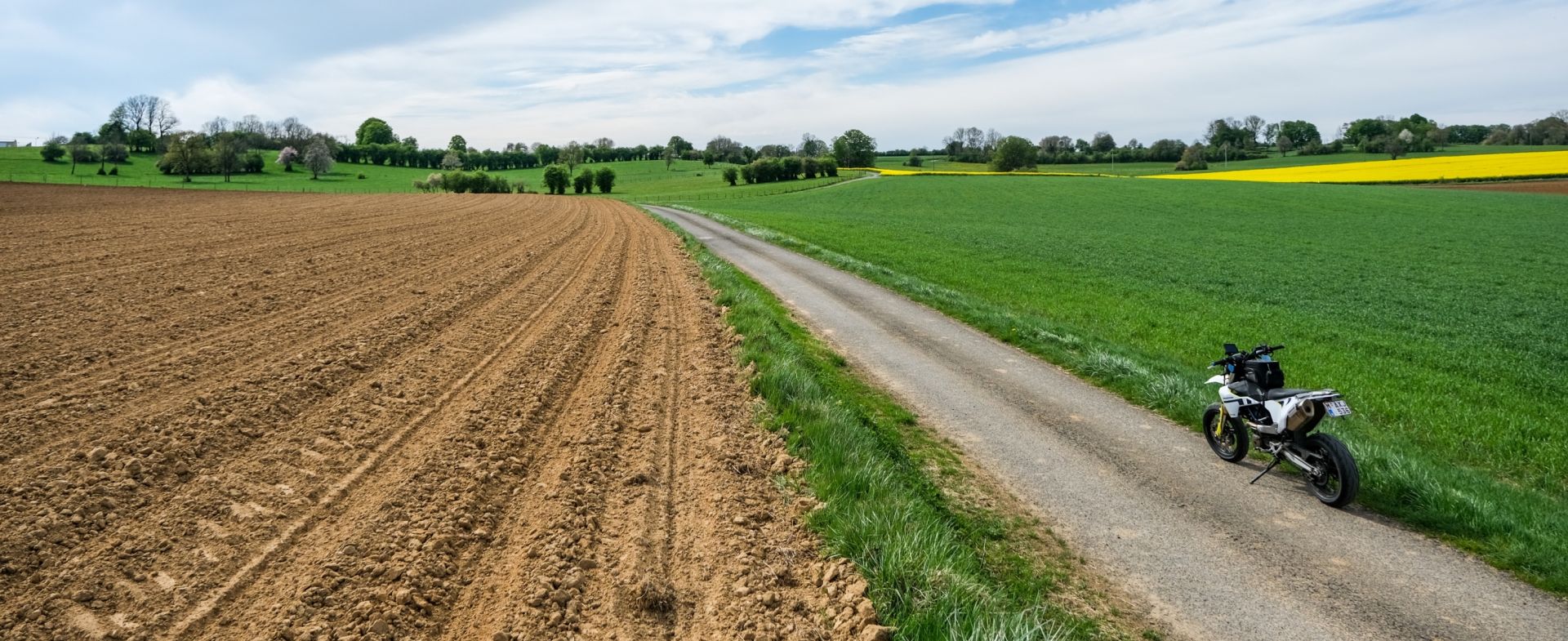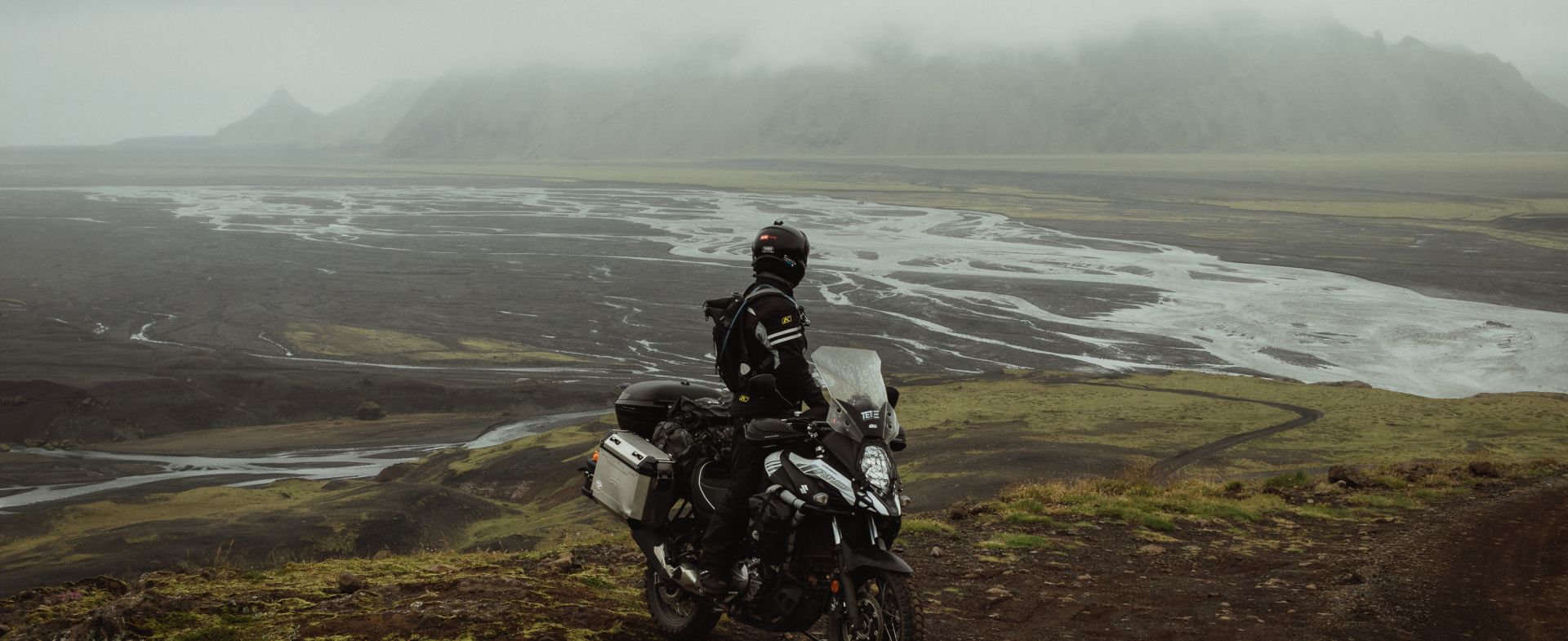Yet, we are inventive and think of a way to make a nice varied trip, neatly within the borders of our own country. We’ll dazzle you with a 1286 km long ride that follows the contours of the country and constantly flirts with the national borders.
Along the Belgian border
Motorcycle Diaries
Due to the corona crisis, we are forced to stay in our own country. Living in a small country like Belgium means that it is not easy to take your motorcycle and go on a big adventure.
I start at the Noorderkempen. The track mainly runs through field roads, extensive farmlands and newly sown fields. Above Hoogstraten, Meer and Wuustwezel you will find a surprising number of beautiful roads. The vastness and open space are delightful. This is a strong start! From Essen to Antwerp things are a bit less interesting: busy traffic and nothing much to see.
The city of Antwerp itself, on the other hand, still treats you with some beautiful views. The majestic harbor house of the renowned architectural firm Zaha Hadid Architects, for example, is a must-see. A hard to miss landmark.
The Waasland Tunnel takes you to the left bank of the city – you’ll ride under the Schelde - and after a few minutes you will find yourself once more in the Flemish fields.
A narrow road follows the E34 and passes through the smallest villages of East Flanders. Because of the corona measures (and the nice weather) it seems that everyone started to cycle. As a result, quite a few cyclists ride these otherwise quiet little concrete lanes. So, watch out and drive carefully.
Riding in a slow pace also creates the opportunity to look around and enjoy the beautiful landscape.
When you follow the very small roads that run close to the NL border, you’ll end up in Zelzate.
From here you’ll experience some more typical dike roads. These winding narrow roads meander through the polders and leave you with an instant smile.
Driving along the edges of the beautiful Zwin nature park the scent of the salty sea air welcomes you. Knokke Heist, the most northerly coastal town in Belgium, marks the start of the coastal route.
Due to the lockdown, it is very quiet in these otherwise overcrowded bathing cities. It is an unreal sight to see the empty and deserted beaches on a sun-drenched day.
The advantage of this relative peace is that you reach Oostende quickly. From the Queen of seaside resorts, the road continues along beaches and the typical Belgian coast high-rise buildings. In Middelkerke the road takes you a bit further inland. You’ll arrive back at the sea in Nieuwpoort. From here on you drive a little further to De Panne and then head back inland along the French border, in an easterly direction.
It is a relaxed route along fields and waterways; the only traffic we saw was a tractor or a milkman. Through unsightly small villages and on concrete roads you drive under Veurne in the direction of Poperinge. You don’t get to the centers of these cities; the track always tries to stay as close to the border of the country as possible.
At Westouter you suddenly see some hills. The landscape that has been as flat as a pancake for the entire ride now becomes somewhat sloping. In this otherwise touristy Heuvelland it is unreal to see that everything is closed and you hardly see anyone.
Crossing the language border does not change the vastness and the peaceful surroundings. In the cities of Wervik, Menen and Mouscron nature is making space for buildings and concrete. These somewhat larger municipalities just below Kortrijk are busier in terms of traffic. But that gives you the opportunity to find something to eat or drink. Because in the middle of the fields there is hardly anything to eat or to entertain you.
The more urban environment is short-lived; soon you dive back into the field roads and continue your way further southeast of the country. A series of rural roads with occasional small village centres is your habitat for the next few hours.
The cliché images of the impoverished Hainaut province certainly pop up, but you will also find surprisingly fresh and modern buildings.
After all those hundreds of kilometers through flat roads, some more hills are finally in sight. The Ardennes are getting closer!
Once you have crossed the river Maas just under Dinant, the roads start to get a bit more twisty and the hills become more numerous and higher. In the traditional Ardennes tradition the asphalt is not always in top form, but that certainly does not spoil the fun.
Occasionally you’ll cross a piece of dirt road. Actually, I have no idea whether it is legal or not to drive these roads. But I take the risk because there is no prohibition sign in sight. In any case, it makes for particularly beautiful views and provides you with some more adventure. The paths are not steep or single tracks, and they are bone dry. My Bridgestone street tires handle these unpaved strips very well. If it is wet, it can be a bit of a challenge.
Although there is a small-unpaved section that is almost on the border with France, I have to deviate from it. A sign tells me this road is prohibited for all motorized traffic. The small detour is even better than this unpaved road. The N819 takes you to one of Belgium's most famous and beautiful views.
From the balcony in Rochehaut you have a fantastic view over the meander of the river Semois and the village of Frahan, which is neatly sitting in the river bend.
Along Bouillon, it goes further south to make a turn to the north again, in the extreme southern tip of our country, the town of Virton.
With the Luxembourg border within reach and mostly smooth asphalt under the wheels, the track continues towards Arlon. Via wonderfully small country roads and godforsaken villages such as Grendel, Nothomb and Parette, you take the N4 for a moment, which leads you to Martelange.
You remain on Belgian territory, but the right side of the street belongs to Luxembourg. That same right side of the road is also dotted with about 10 petrol stations where you can refuel just a little cheaper.
With a full fuel tank I continue on the road over Bastogne towards the German-speaking part of the country. Along straight roads you cross the Haute Fagnes and arrive at Signal de Botrange. With its 694m it is the highest point in Belgium.
The route continues through Eupen back to the Flemish part of the country and after the bendy pleasure of the Ardennes, the straight roads are a bit more boring.
The hilly Voeren region with its beautiful villages makes up for it all over again and provide instant driving pleasure.
Just above Visé you cross the Maas again. And end up in the busier Flemish part of the country. It’s time to adjust again after the expanse of the southern part of the country.
I make a last turn to the West through the sandy Kempen with its fields and pine trees and the circle is complete!
A very beautiful varied and especially surprising route! So many impressions and differences within the same country. This alone makes it more than worthwhile to take this ride.
This track is a guide, a suggestion ... and it is by no means the only real way to follow. There are road works, traffic conditions change, there may be villages, cities, sights you want to visit, ... So, you will certainly have to deviate from the route every now and then and improvise yourself. Make shortcuts, detours, ... or follow the lines neatly on your GPS, but above all, enjoy your ride!






























